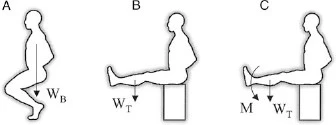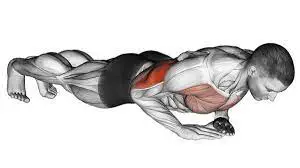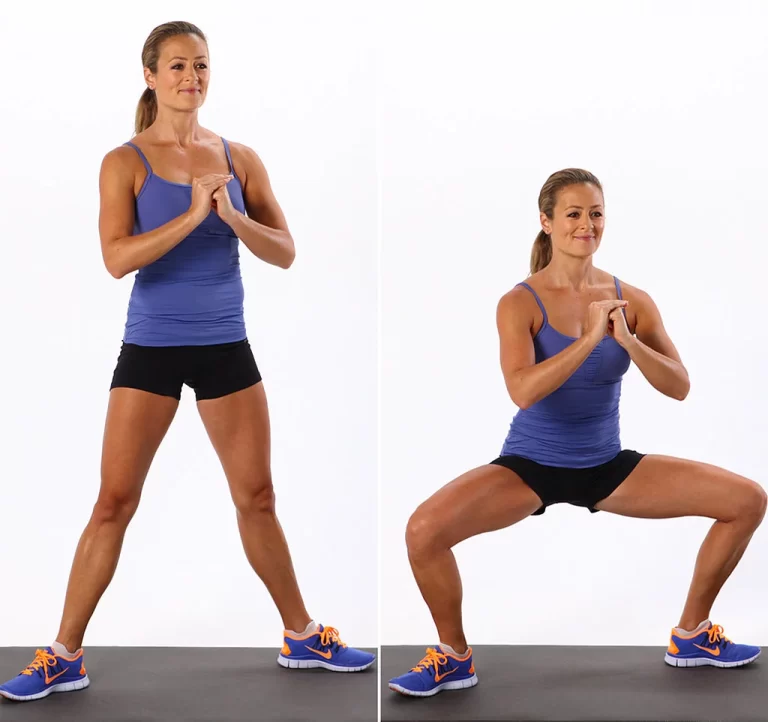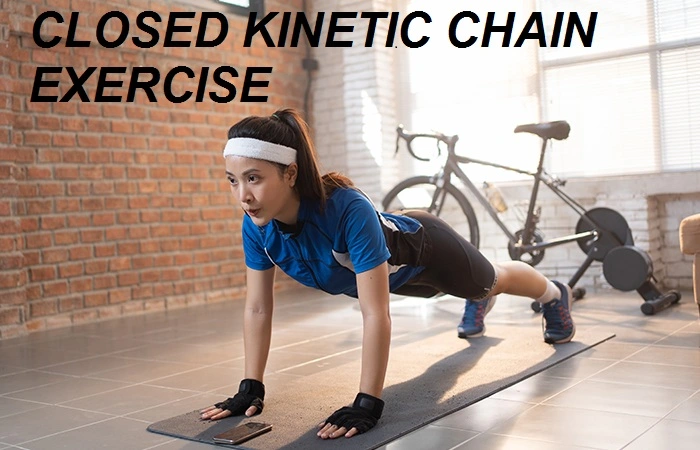Closed Kinetic Chain Exercise
Exercises known as “Closed Kinetic Chains” include moving the proximal segments of the body while the distal segments, such as the foot or hand, are immobile or in touch with a solid surface. The majority of these workouts require numerous joints to cooperate in a coordinated manner while bearing weight.
Exercises that involve a closed kinetic chain involve the transmission of body forces from the proximal to the distal segments of the chain. Open kinetic chain exercises, in which the distal section is allowed to move in space, are frequently used to contrast this kind of training.
Table of Contents
What is a Kinetic chain movement?
The kinetic chain, also referred to as the kinematic chain, is an engineering concept used to represent human movement. It is used in a variety of clinical settings, including those involving the musculoskeletal system, sports medicine, neuro-rehabilitation, prostheses, and the development of orthotics.
The concept was first put forth by mechanical engineer Franz Reuleaux in 1875. In order to create a system where movement at one joint influences or causes movement at another joint in the kinetic link, he proposed that joints connect stiffly, overlapping the segments.
Dr. Arthur Steindler updated Reuleaux’s theory in 1995 by taking into account physical activity, sport-specific activity patterns, and a study of human mobility. He recommended that instead than thinking of the extremities as flexible, overlapping segments in succession, we should think of them as demanding.
The kinetic chain exercise, in accordance with his definition, is “a combination of several consecutively arranged joints creating a complex motor unit.” This chain or series could either be closed or open.
What is a closed kinetic chain?
When the distal component encounters “considerable” external resistance that restricts unconstrained movement, the exercise becomes a closed kinetic chain.
In this configuration, neither the proximal nor the distal components are able to move.
Unfortunately, the lack of a numerical number in Steindler’s original definition of “considerable” led to confusion and issues over what constitutes an indeed closed kinetic chain movement.
Accurate closed kinetic chain movement patterns never happen in the extremities when there is no motion, with the exception of isometric exercises. Contrastingly, in clinical practice “resistance is placed through the distal aspect of the extremity and remains fixed.”
The best example of this is the standing squat because the athlete’s body weight or added weight provides significant resistance to the surface while the feet remain firmly planted. Closed kinetic chain exercises have been utilized more frequently in rehabilitation programs for more than 20 years due to their inherent functional stimulation.
Exercises using closed kinetic chains features:
As an illustration, consider the standing squat:
The tibiofemoral joint experiences a linear stress distribution as a result of axial joint loading.
The many joints and multiple-joint axes present in the hip, knee, ankle (talocrural), and subtalar joints all provide movement.
An increase in muscular co-contraction is required at both segments where simultaneous movement occurs in order to stabilize and control the motions at the chain’s joints.
Movement occurs simultaneously in both parts. To stabilize and control the concurrent segmental movement, additional joint movement and muscle co-contraction are required.
Exercises with a closed kinetic chain have the following features:
- linear stress patterns
- Mobility of many segments
- Once Supported with joint stability of multiple joints
- Multi-joint axis
Many muscles must contract simultaneously with many moving parts in order to stabilize and control motion across numerous joints.
The rest of the leg chain, including the ankles, knees, and hips, will move toward the fixed end of the extremity, the feet when the body drops into the squatting position if the feet are firmly planted on the ground during a squat.
When executing an open chain exercise, such as sitting leg extensions on a weight machine or biceps curls with dumbbells, the distal end of an extremity can move freely in space.
By promoting joint stability, closed-chain motions can involve more muscles and joints. Closed-chain movements can also be used to perform a variety of common joint-involving activities, which could enhance neuromuscular coordination and overall joint health. Since they intentionally incorporate balance and body awareness (proprioception) and train movement rather than specific muscle groups, many closed-chain exercises are therefore considered “functional” and used in programming for functional training goals.
Biomechanics of lower extremity closed kinetic chain activities
Foot and Ankle
A closed kinetic chain causes supination during weight bearing when the talus abducts and dorsiflexes on the bone and the calcaneus inverts on the talus. The external rotation of the tibia causes knee extension. During supination, the plantar flexors assist in stabilizing the foot, slowing the tibia, and flexing the knee.
Knee Joint

The sports trainer must comprehend the stresses that exist around the knee joint. Palmer et al. suggested a biomechanical model of the lower extremities that assesses two significant forces at the knee joint.
If not for restrictions in soft tissues, notably the anterior cruciate ligament (ACL), the tibia would translate anteriorly under shear stress in the posterior direction. A compressive force is delivered to the tibia’s longitudinal axis as the second force. Weight-bearing exercises encourage joint compression, which enhances joint stability. The hamstrings’ simultaneous contraction lessens the shear force.
The hamstrings contract as a result of exercises with a closed kinetic chain, stabilizing the hip while the quadriceps stabilize the knee, causing a flexion moment at the hip and knee. A moment is the sum of a force and a distance from the axis of rotation. It is also known as “torque,” and it describes the turning action that takes place when a force is applied to a body that is rotating around a fixed point. The hamstring muscles’ ability to contract helps the quadriceps’ tendency to cause anterior tibial translation. when the axial orientation of the tibial axis is the direction of the resistive force.
Contraction of the hamstrings is the most efficient way to reduce shear stress during weight-bearing activities.
Co-contraction of the knee joint:
According to various studies, co-contraction helps to stabilize the knee joint and lessen shear loads.
The trunk’s little anterior flexion may put additional strain on the hamstrings.
During trunk flexion, the center of gravity shifts anteriorly, reducing the knee flexion moment and, therefore, the knee shear force and patellofemoral compression forces. Closed kinetic chain exercises aim to reduce knee flexion while increasing hip flexion. A flexion moment is also created at the ankle when the resistive force is applied to the sole of the foot.
The soleus muscle produces a knee extension moment that stabilizes ankle flexion and aids in lowering anterior shear stress. As a result, the entire lower extremity kinetic chain is engaged by applying an axial force at the distal segment.
Patellofemoral Joint
In a closed kinetic chain exercise, when the knee flexes, the flexion movement increases, increasing the tension in the quadriceps and patellar tendon, which in turn raises the response forces at the patellofemoral joint. The patella’s noticeably larger surface area of contact with the femur, however, reduces contact stress. The patellofemoral joint may respond better to exercises with a closed kinetic chain because contact stress is decreased.
Exercises utilizing the closed kinetic chain can help heal lower extremity wounds.

Thanks to significant improvements in surgical techniques brought about by technological breakthroughs, athletic trainers today follow a distinct rehabilitation philosophy. Numerous papers have backed early 1990s research that advocates the wider use of closed kinetic chain exercises. However, the most recent systematic reviews of the research reveal that there is still some debate on whether closed or open kinetic chain activities should be the first course of treatment following an ACL tear or repair.
Exercises combining the open and closed kinetic chains have been associated with both patellofemoral pain syndrome therapy and ACL rehabilitation. Closed kinetic chain workouts have been suggested by a number of recent research as the most efficient for restoring knee function after ACL damage, however, other studies have disagreed. The best time to start open-chain exercises is still unknown because they appear to lessen anterior shear of the ACL, promote dynamic early joint stability, and stimulate proprioceptors. However, it was also suggested that closed-chain exercises can be used safely early in the postoperative period while open-chain exercises should be used later in the rehabilitation process.
Who can benefit from CKC exercise?
Everyone responds quickly. Yes, including closed kinetic-chain exercises in addition to open kinetic-chain exercises is essential for your programming. Closed kinetic-chain exercises can enhance joint stability and also improve functional movement patterns.
Therefore, closed kinetic-chain activities are advantageous for both the general population and athletes.
Due to the weak link, the chain might go either forward or backward. The joint above or below any chain link that is out of alignment may be affected. For instance, when the knee does not move through the range of motion adequately when walking, the ankle or the hip may need to modify to accommodate for the difference in movement.
Advantages of CKC over OKC
Instead of muscles operating in isolation, closed-chain workouts allow antagonistic muscle groups to be activated simultaneously (for example, the quadriceps and hamstrings during leg squats). Enhancing joint stability is encouraged, and functional movement patterns are mimicked. Lower-extremity closed kinetic chain exercises have frequently been touted as a more useful type of exercise for the rehabilitation program of the lower extremities since sports-related activities are performed with the feet in fixed positions.
Due to their biomechanical and functional advantages, closed kinetic chain activities may be best suited for the rehabilitation of the ACL.
There are several benefits to working out at CKC. The report says one is that it keeps everything balanced. In fact, it was shown that this type of exercise was more effective at improving balance than open-chain training.
Athletes need to stay upright while doing various tasks on the field or court, which requires them to maintain their balance. Balance is necessary when a figure skater lands from a jump.
It also allows you to bend to pick something up off the ground. If you have a strong balance, you can undertake these activities without being harmed.
Close kinetic chain exercise benefits in UE
- Develops and strengthens the core’s and the shoulder girdle’s neuromuscular control
- Early on in rehabilitation, muscle recruitment and co-contraction are used to prevent muscular stiffness.
- improves and boosts the UE’s dynamic joint stability
- Joint approximation and compression serve to increase joint and muscle power and the strength of muscular contractions.
Close kinetic chain exercise benefits in LE
- Normal LE function requires the foot to operate as a biomechanical shock absorber, foot stabilizer, acceleration, and deceleration.
- The tibiofemoral joint’s shear force is decreased by the hamstring’s co-contraction during the CKC exercise.
- During CKC exercises, the femur’s contact area is extended, reducing the compressive stress on the patellofemoral joint.
Closed kinetic chain upper body exercises

- Push-ups and its offshoots, such as handstands
- Chin-ups or pull-ups
- Backward row and dips
- Focus on triceps, biceps, deltoids, pectorals, lats, abdominals, and lower back co-contraction to stabilize in a range of ratios depending on angle and leverage.
Closed kinetic chain lower body exercises

- Deadlifts and Squats
- Lunges
The co-contraction of the gastrocnemius, soleus, hamstrings, and quadriceps muscles is the emphasis of deadlifts and power cleans.
In each of the aforementioned actions, the body rotates around the fixed joint since the distal end of the extremity is fixed.
Disadvantages of CKC exercises
Exercises with closed chains have a number of serious drawbacks. The main one arises because, when performing closed-chain exercises, you are essentially confined to a small space.
The “CLOSED” chain exercises, as the name suggests, limit you to a specific area.
This might not be a problem for the majority of people, but if plyometric training or a certain activity is all you focus on, it might be a big problem. This is a big drawback that may seriously limit you and your potential if you were to pursue these goals while solely taking part in closed-chain activities.
The regular pattern of movement that occurs during closed kinetic chain activity may not be possible when there is some dysfunction associated with the injury because of soreness, edema, muscle weakness, or restricted range of motion. The result is movement compensations, which interfere with muscle activation and organic movement.
If only closed kinetic chain activities are carried out, the joints that are closest to or farthest from the injury may not exhibit a deficiency. Without the use of open kinetic chain exercises that isolate certain joint movements and obstruct full healing, the insufficiency might not be remedied. The therapist should choose the best open or closed kinetic chain exercise for the specific situation.
Closed kinetic chain exercises combine isometric, concentric, and eccentric contractions that must occur concurrently in a number of muscle groups to create multiplanar motion at each of the joints in the kinetic chain.
For closed kinetic chain activities, the synchronization of increasingly complex agonist and antagonist muscle responses is required.
Summary
Depending on your goals and preferences, this will be the deciding factor as to whether closed-chain or open-chain exercises are preferable for you. As I’ve already mentioned, closed-chain workouts are more well-known for heavy movements like bench presses and barbell squats. Closed-chain workouts should be just up your alley if your objectives are to increase your strength development and become as powerful as you can.
FAQ
What are exercises with closed kinetic chains versus open kinetic chains?
Exercises using kinetic chains can be divided into open or closed categories. The distal aspect, which mostly refers to the hand or foot in open kinetic chain activities, is the section that extends the farthest from the body and is not connected to anything. In an exercise with a closed chain, it is fixed or stationary.
What are the benefits of closed kinetic chain exercises?
Instead of muscles operating in isolation, closed-chain workouts enable the simultaneous activation of antagonistic muscle groups (such as the quadriceps and hamstrings during leg squats). As a result, improved joint stability and imitation of practical movement patterns are encouraged.
What does a closed chain movement look like?
In contrast to open-chain exercises, these closed-chain workouts include the body moving while the limbs are mainly immobile. Because your feet remain on the ground and your quadriceps do all the effort, squatting is a closed-chain exercise.
Why are workouts with a closed chain beneficial for the knee?
Joint compression is typically emphasized in exercises with a closed chain, which helps stabilize joints like your knee during the upright stance phase of squats. There is typically more shearing force applied parallel to the joint while exercising with an open chain; during a leg extension, for example, there is never any compression force exerted on the knee.
What workouts with a closed kinetic chain have limitations?
The regular pattern of movement that occurs during closed kinetic chain activity may not be possible when there is some dysfunction associated with the injury because of soreness, edema, muscle weakness, or restricted range of motion. Movement compensations as a result interfere with muscle function and regular movement.
Are step-ups closed chains or open chains?
Exercises that use closed kinetic chains are called step-ups. It facilitates the use of the knee rehabilitation program.
Reference
Closed Kinetic Chain Exercise – Benefits, Biomechanics – Mobile. Mobile Physiotherapy Clinic. https://mobilephysiotherapyclinic.in/closed-kinetic-chain-exercise/
12 Effective Open And Closed Kinetic Chain Exercises. (2023, February 6). STYLECRAZE. https://www.stylecraze.com/articles/closed-and-open-kinetic-chain-exercises/






One Comment